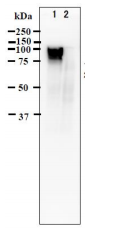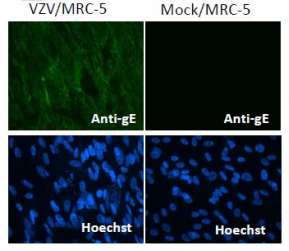Description
Varicella Zoster Virus (VZV) is one of eight herpes viruses known to infect humans and vertebrates. VZV only affects humans and commonly causes chickenpox in children, teens and young adults and herpes zoster (shingles) in adults and rarely in children. VZV is known by many names, including chickenpox virus, varicella virus, zoster virus, and human herpes virus type 3 (HHV-3).
VZV infects the nerves and causes a wide variety of symptoms. After the primary infection (chickenpox), the virus goes dormant in the nerves, including the cranial nerve ganglia, dorsal root ganglia, and autonomic ganglia. Many years after the patient has recovered from chickenpox, VZV can reactivate to cause a number of neurologic conditions.
gE is an envelope glycoprotein that binds to the potential host cell entry receptor IDE. In epithelial cells, the heterodimer gE/gI is required for the cell-to-cell spread of the virus, by sorting nascent virions to cell junctions. Once the virus reaches the cell junctions, virus particles can spread to adjacent cells extremely rapidly through interactions with cellular receptors that accumulate at these junctions. gE/gI has been implicated in basolateral spread in polarized cells. In neuronal cells, gE/gI is essential for the anterograde spread of the infection throughout the host nervous system. Together with US9, the heterodimer gE/gI is involved in the sorting and transport of viral structural components toward axon tips. The heterodimer gE/gI serves as a receptor for the Fc part of host IgG. Dissociation of gE/gI from IgG occurs at acidic pH which suggests it may be involved in anti-VZV antibodies bipolar bridging, followed by intracellular endocytosis and degradation, thereby interfering with host IgG-mediated immune responses .
gE consists of 623 amino acids with 70 kDa mass. It is phosphorylated on serines within the acidic cluster. Phosphorylation determines whether endocytosed viral gE traffics to the trans-Golgi network or recycles to the cell membrane.
Product: Produced by hybridoma grown in serum-free medium and purified by proprietary chromatography procedure under mild conditions.
Applications
Western blot 1:2,000-5,000 dilution
Immunoprecipitation 1:100 dilution
Immunofluorescence staining 1:50-100 dilution
Immunocytochemistry 1:50-100 dilution
ELISA is assay dependent
Specification
Immunogen: Varicella-zoster virus Oka strain (vaccine strain)
Specificity: Reacts with gE of VZV
Isotype: mouse IgG2a kappa
Purity: 90~95% pure by SDS-PAGE
Form: 1 mg/ml in PBS, 50% glycerol, filter sterilized. Azide- and carrier-free.
Storage: Shipped at 4°C and upon arrival, spin-down and store at -20°C
Data Link
UniProt Q9J3M8 (GE_VZVO)
Reference
- Okuno T. et al. Synthesis and processing of glycoproteins of Varicella-Zoster virus (VZV) as studied with monoclonal antibodies to VZV antigens. Virology. 1983 Sep;129(2):357-68.
- Shiraki et al. Neutralizing anti-gH antibody of Varicella-zoster virus modulates distribution of gH and induces gene regulation, mimicking latency. J Virol. 2011 Aug;85(16):8172-80. doi: 10.1128/JVI.00435-11.

Fig. 1 Identification of gE protein in VZV-infected cells by Western blot using anti-VZV gE antibody (clone #9). Lane 1: VZV strain pOka infected MRC-5 cell lysate, Lane 2: MRC-5 cell lysate (uninfected negative control). The anti-VZV gE antibody was used at 1/5,000 dilution.

Fig. 2 Immunofluorescence staining of VZV gE protein in VZV-infected MRC-5 cells by using anti-VZV gE antibody (clone #9). Anti-VZV gE antibody was used at 1/100 dilution. Secondary antibody, Alexa Fluor 488 donkey anti-mouse IgG [H+L] (Life Technology No. A21202) was used at 1/200 dilution. Nuclei were stained with Hoechst 33342.


Reviews
There are no reviews yet.